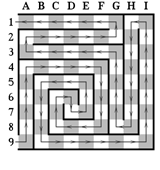
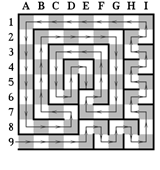
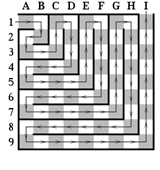
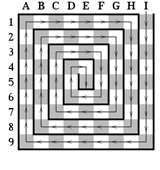
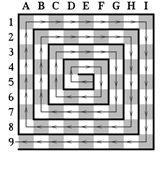
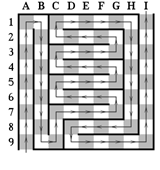
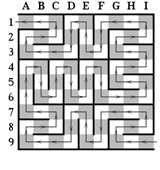
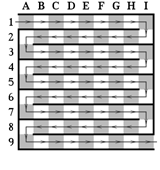
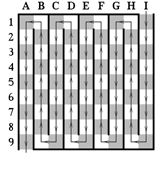
Copyright © 1999 by Lenna A. Mahoney
DUERROR GRANDIS is a popular Roma Novan board game that my third dopple "Lainley" passed along to the Club through Theofe.
SUMMARY
In this Roma Novan game each player chooses a separate board, then follows that board's unique path from its start to its end (winning) square. However, you should think of the game as played on a single board on which each player takes a different path.
Each game turn has four parts. First, piece selection. You use only one piece at a time, with three pieces that you may choose among at each turn. Each piece has different capabilities. To change pieces, you must pay a token or roll an odd number on a die. Next, you may choose to take other players, if a take is possible. If you can take, but refuse to, you get paid with a token. Third, you may choose to veer (go to a random location, selected by die rolls). You cannot veer without paying a token. Finally, you must either pay a token or move, even if you do nothing else in the turn.
The RoNos usually have two to four players in a game.
THE BOARD
Each board is subdivided into a grid of 81 squares. From the left to the right of a board, each of the nine columns of squares is identified by a letter. Each of the nine rows from top to bottom is identified with a number. Every square has its own identification code of one letter and one number. Every game board has the same grid but a different path from the start square to the end square. Therefore each player follows a different path, which can cause some confusion. To simplify keeping track of several different players, you should put appropriately colored markers on your own board in the same squares as those occupied by the other players on their own boards. When your piece changes locations, tell the other players which square you came from and which you went to, using the letters and numbers marked on the sides of the board.
Thumbnail images of several typical boards are shown below; click on them to get large images (about 19 KB each) suitable for printing.
STARTING
Players start by rolling a die to determine whose turn will come first. The player with the highest roll gets the first turn and makes the first choice of piece color and of game board. The other players get their turns and their choices in counter-clockwise (sinistrorsus) order around the table. Players need not pay to choose which piece to start with.
Players' pieces do not start on the board. Each makes the first step of the first move onto its starting square. Because players do not start on the board, no taking can occur during the first turn. Players can veer on the first turn.
Each player starts with one token. The bank also starts with one token.
PIECES
Each player has three pieces available to him, the thete, the ephebe, and the melliran. However, a player can only have one of these pieces on the board at a time. Each player begins the game using whichever of the three pieces he prefers. The capabilities of the three pieces are as follows:
Thete -- cannot take at all. It moves the fastest, exactly nine squares in each turn.
Ephebe -- can take any piece within a 5-by-5 block centered on it. The ephebe can also take a piece on the same square with it. Its move is exactly five squares.
Melliran -- can take any piece in line with it, whether the line lies horizontal, diagonal, or vertical. It can also take a piece on the same square with it. The take works like a queen's in chess, except the melliran can jump over intervening pieces. The melliran moves the slowest, one square per turn.
PLAYING
The first part of each turn, which is optional, allows piece selection (formactus). You can only change pieces during this part of the turn. You must use the piece you choose now through the rest of the turn. Changing your piece costs one token, which you pay to the bank. Or, instead of paying, you may roll the die. An odd number means you can change pieces without paying. An even number means you cannot change even by paying.
The second part of the turn depends on whether you can take some other player's piece (flictus). If you do not have a potential take, go on to part three of the turn, veering. If you can take another player, you may choose to do that. To take, change places with your victim. If you can take, but choose not to (misericordia), take a token from the bank. If the bank has no tokens, take one from your victim. If there is more than one victim, you may choose which one pays. When neither the bank nor your victim has tokens, you do not get paid for choosing not to take.
Complex cases may arise during the "taking" part of the turn. If there are two or more players on the same square whom you can take, you may choose which to take but you can only take one of them. You may make more than one take, if you can do so in sequence. (That is, you take player A and trade places with him. Then from the new location you can take B and trade places with him, so he is now where A originally was. And so on.) You may take a player's piece more than once, if the new location you put him on permits a take from where you are. If you take one piece during a turn, even though there are others you refuse to take, you cannot get any token. You can get, at most, one token during a turn no matter how many pieces you refrain from taking.
The third part of the turn, which is optional, is called veering (flexus) by the RoNos. It costs one token. You can veer on your first turn. To veer, first put a token in the bank. Then roll a ten-sided die twice, first to get the letter of your new position, second to get the number. If neither die shows a number between 1 and 9 (including 1 or 9), go back to the first square of your path. If only one die shows a number between 1 and 9 (inclusive), do not relocate your piece. If both dice show a number between 1 and 9 (inclusive), go to the new position indicated by the die. You may spend as many tokens as you have to make a series of veers in one turn.
The fourth and last part of the turn is moving (fluctus). Move as many squares along your path as your piece permits. You must move during the last part of the turn, no matter what you did in the first three parts, unless you pay a token to the bank to be allowed to stay where you are. The exception is when you are so close to your end square that you cannot move (see "Winning").
Nothing happens when you land on the same square as another player when one of you is veering or moving.
Players and the bank must keep all their tokens in plain view so that the token counts are known to all.
WINNING
The game ends when a player wins, which is accomplished by moving exactly one square further than his own end square. Therefore, if you take, move, or veer directly onto your end square you must still move exactly one square further to win (which requires a melliran).
HINTS
If you veer using a 10-sided die with numbers rather than letters, the letter-number equivalences are as follows:
1 --> A 4 --> D 7 --> G 2 --> B 5 --> E 8 --> H 3 --> C 6 --> F 9 --> I
VARIATIONS
"Caecus (blind)": the players cannot see each others' boards. They track each other by the letter-number coordinates of the squares. Each player must deduce other players' paths (and how close they have come to winning) without seeing them.
"Parcus (frugal)": when the game ends, players may save their tokens for the subsequent games, which start with a freshly filled bank.
"Factiosus (gang warfare)": Each player may have all three of his pieces on the board at once. Therefore, the piece-choosing part of the turn is omitted. On each turn, you may make the decisions regarding taking, saving, and veering for every piece you have on the board. In each part of your turn you may use your pieces in any order you like. It need not be the same order in every part of a turn, or on every turn. The player who wins is the one who gets all his pieces off the board first.
"Merus (bare-bones)": A simplified version of the game. The bank starts with one token for each player, and the players start without tokens. Each player can use only two pieces, the thete and the melliran. All other rules stay the same as in the basic game.